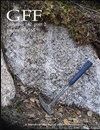俄罗斯乌拉尔南部志留纪(温洛克)腕足类和海百合类新记录
IF 1.2
4区 地球科学
Q2 GEOLOGY
引用次数: 1
摘要
摘要乌拉尔南部子莱尔地区志留系乌兹扬组中存在海百合类和腕足类。笔石Coronograptus preedeubeli的出现表明该地层的年龄为晚荷马时代(温洛克)。新发现的异种海百合,Cicerocrinus gracilis Donovan sp. nov.,是该属已知最古老的成员。它有一个长,灵活和同形的柱,和一个高苔藓虫古生物学术语(IBr2)(第二原臂)腋窝。以前所描述的所有西塞罗林属物种都局限于不列颠群岛的勒德洛、瑞典和爱沙尼亚,以及爱沙尼亚的普里多利。保存较差的腕足动物群以小型Atrypa (Atrypa?(sp.)和dalmanellid腕足动物(Levenea?sp)。所报道的组合一般生活在深水环境。本文章由计算机程序翻译,如有差异,请以英文原文为准。
New records of brachiopods and crinoids from the Silurian (Wenlock) of the southern Urals, Russia
ABSTRACT Crinoids and brachiopods are described from the Silurian Uzyan Formation of the Zilair Zone in the southern Urals. The occurrence of the graptolites Coronograptus praedeubeli suggests a late Homerian (Wenlock) age for the strata. A new disparid crinoid, Cicerocrinus gracilis Donovan sp. nov., is the oldest known member of this genus. It has a long, flexible and homeomorphic column, and a tall bryozoan palaeontology terminology (IBr2) (second primibrachial) axillary. All species of Cicerocrinus described previously have been limited to the Ludlow of the British Isles, Sweden and Estonia, and the Pridoli of Estonia. The poorly preserved brachiopod fauna is represented by small atrypid (Atrypa? sp.) and dalmanellid brachiopods (Levenea? sp.). The reported assemblage generally inhabited deep-water environments.
求助全文
通过发布文献求助,成功后即可免费获取论文全文。
去求助
来源期刊

Gff
地学-地质学
CiteScore
2.80
自引率
10.00%
发文量
11
审稿时长
>12 weeks
期刊介绍:
GFF is the journal of the Geological Society of Sweden. It is an international scientific journal that publishes papers in English covering the whole field of geology and palaeontology, i.e. petrology, mineralogy, stratigraphy, systematic palaeontology, palaeogeography, historical geology and Quaternary geology. Systematic descriptions of fossils, minerals and rocks are an important part of GFF''s publishing record. Papers on regional or local geology should deal with Balto-Scandian or Northern European geology, or with geologically related areas. Papers on geophysics, geochemistry, biogeochemistry, climatology and hydrology should have a geological context. Descriptions of new methods (analytical, instrumental or numerical), should be relevant to the broad scope of the journal. Review articles are welcome, and may be solicited occasionally. Thematic issues are also possible.
 求助内容:
求助内容: 应助结果提醒方式:
应助结果提醒方式:


